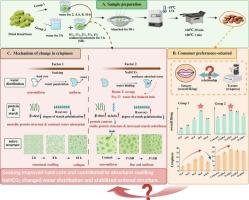The influence of soaking pretreatment on the mouthfeel and crispiness of fried broad beans (Vicia faba L.) and its mechanism
IF 9.8
1区 农林科学
Q1 CHEMISTRY, APPLIED
引用次数: 0
Abstract
Consumers dislike fried broad beans with hard core due to inadequate crispiness, so an alternative approach with its mechanism is proposed in the present work. Results showed that the optimum soaking procedure was that 5 h in water followed by 3 h in 2 % NaHCO3. For water soaking process, water absorption, starch gelatinization and protein structure played antagonistic roles. As time lengthened, increased water uniformity and starch gelatinization (11.87 % to 92.36 %) induced structure swelling which was beneficial for later crispiness formation, but β-sheet dropped to 41.50 % which indicated the collapse of structure due to excessive soaking. NaHCO3 enhanced crispiness through increased multilayer adsorbed water (17.03 % to 24.62 %) which occupied pores at room temperature and fled at fried temperature. It also promoted short-range order of starch (R1047/1022 from 0.45 to 0.82) and the increase of β-sheet and α-helix in protein, contributing to a more stable internal network with uniform pore distribution.

浸泡预处理对炒蚕豆口感和脆度的影响及其机理
消费者不喜欢硬核炒蚕豆,因为脆度不够,所以本工作提出了一种替代方法来研究其机理。结果表明,最佳浸泡时间为5 h, 2 % NaHCO3浸泡时间为3 h。在水浸泡过程中,吸水率、淀粉糊化率和蛋白质结构起拮抗作用。随着时间的延长,水分均匀度和淀粉糊化程度的提高(11.87 % ~ 92.36 %)引起结构膨胀,有利于后期酥脆的形成,但β-sheet下降到41.50 %,表明过度浸泡导致结构崩溃。NaHCO3通过增加多层吸附水(17.03 % ~ 24.62 %)来增强脆度,这些水在室温下占据孔隙,在油炸温度下逸出。它还促进了淀粉的近程序(R1047/1022从0.45到0.82)和蛋白质中β-sheet和α-helix的增加,使内部网络更加稳定,孔隙分布均匀。
本文章由计算机程序翻译,如有差异,请以英文原文为准。
求助全文
约1分钟内获得全文
求助全文
来源期刊

Food Chemistry
工程技术-食品科技
CiteScore
16.30
自引率
10.20%
发文量
3130
审稿时长
122 days
期刊介绍:
Food Chemistry publishes original research papers dealing with the advancement of the chemistry and biochemistry of foods or the analytical methods/ approach used. All papers should focus on the novelty of the research carried out.
 求助内容:
求助内容: 应助结果提醒方式:
应助结果提醒方式:


